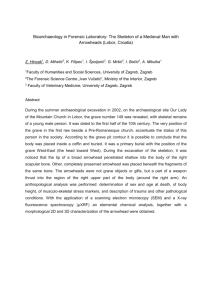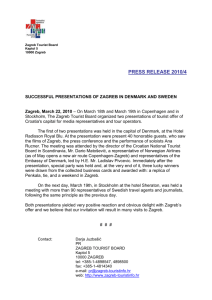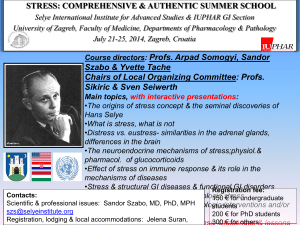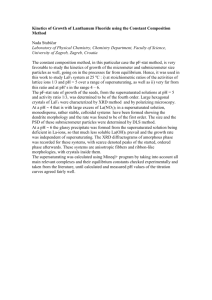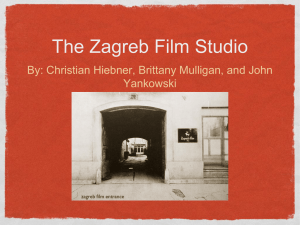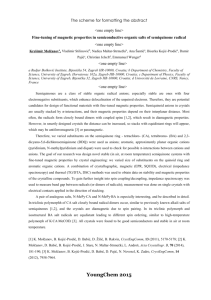page.
advertisement
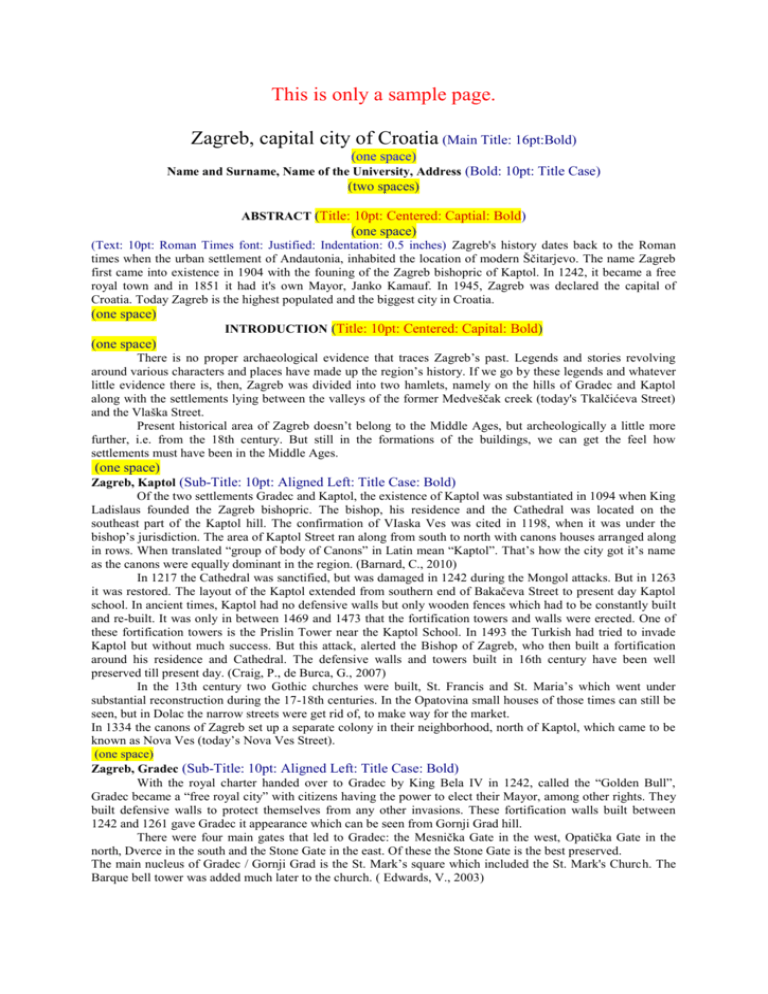
This is only a sample page. Zagreb, capital city of Croatia (Main Title: 16pt:Bold) (one space) Name and Surname, Name of the University, Address (Bold: 10pt: Title Case) (two spaces) ABSTRACT (Title: 10pt: Centered: Captial: Bold) (one space) (Text: 10pt: Roman Times font: Justified: Indentation: 0.5 inches) Zagreb's history dates back to the Roman times when the urban settlement of Andautonia, inhabited the location of modern Ščitarjevo. The name Zagreb first came into existence in 1904 with the founing of the Zagreb bishopric of Kaptol. In 1242, it became a free royal town and in 1851 it had it's own Mayor, Janko Kamauf. In 1945, Zagreb was declared the capital of Croatia. Today Zagreb is the highest populated and the biggest city in Croatia. (one space) INTRODUCTION (Title: 10pt: Centered: Capital: Bold) (one space) There is no proper archaeological evidence that traces Zagreb’s past. Legends and stories revolving around various characters and places have made up the region’s history. If we go by these legends and whatever little evidence there is, then, Zagreb was divided into two hamlets, namely on the hills of Gradec and Kaptol along with the settlements lying between the valleys of the former Medveščak creek (today's Tkalčićeva Street) and the Vlaška Street. Present historical area of Zagreb doesn’t belong to the Middle Ages, but archeologically a little more further, i.e. from the 18th century. But still in the formations of the buildings, we can get the feel how settlements must have been in the Middle Ages. (one space) Zagreb, Kaptol (Sub-Title: 10pt: Aligned Left: Title Case: Bold) Of the two settlements Gradec and Kaptol, the existence of Kaptol was substantiated in 1094 when King Ladislaus founded the Zagreb bishopric. The bishop, his residence and the Cathedral was located on the southeast part of the Kaptol hill. The confirmation of VIaska Ves was cited in 1198, when it was under the bishop’s jurisdiction. The area of Kaptol Street ran along from south to north with canons houses arranged along in rows. When translated “group of body of Canons” in Latin mean “Kaptol”. That’s how the city got it’s name as the canons were equally dominant in the region. (Barnard, C., 2010) In 1217 the Cathedral was sanctified, but was damaged in 1242 during the Mongol attacks. But in 1263 it was restored. The layout of the Kaptol extended from southern end of Bakačeva Street to present day Kaptol school. In ancient times, Kaptol had no defensive walls but only wooden fences which had to be constantly built and re-built. It was only in between 1469 and 1473 that the fortification towers and walls were erected. One of these fortification towers is the Prislin Tower near the Kaptol School. In 1493 the Turkish had tried to invade Kaptol but without much success. But this attack, alerted the Bishop of Zagreb, who then built a fortification around his residence and Cathedral. The defensive walls and towers built in 16th century have been well preserved till present day. (Craig, P., de Burca, G., 2007) In the 13th century two Gothic churches were built, St. Francis and St. Maria’s which went under substantial reconstruction during the 17-18th centuries. In the Opatovina small houses of those times can still be seen, but in Dolac the narrow streets were get rid of, to make way for the market. In 1334 the canons of Zagreb set up a separate colony in their neighborhood, north of Kaptol, which came to be known as Nova Ves (today’s Nova Ves Street). (one space) Zagreb, Gradec (Sub-Title: 10pt: Aligned Left: Title Case: Bold) With the royal charter handed over to Gradec by King Bela IV in 1242, called the “Golden Bull”, Gradec became a “free royal city” with citizens having the power to elect their Mayor, among other rights. They built defensive walls to protect themselves from any other invasions. These fortification walls built between 1242 and 1261 gave Gradec it appearance which can be seen from Gornji Grad hill. There were four main gates that led to Gradec: the Mesnička Gate in the west, Opatička Gate in the north, Dverce in the south and the Stone Gate in the east. Of these the Stone Gate is the best preserved. The main nucleus of Gradec / Gornji Grad is the St. Mark’s square which included the St. Mark's Church. The Barque bell tower was added much later to the church. ( Edwards, V., 2003) On the northwest walls of the Church is positioned the oldest coat of arms of Zagreb with the year 1499 etched on it. The City Hall of the medieval times was situated on present day Čirilometodska Street, which was the seat of city administration. After many alternations and reconstructions, this City Hall is still used by the City Council for meetings. The appearance of Vlaska Street in medieval times is not much known of. In present day VIaska Street, in olden times were situated the archbishop’s residence and gardens. The old row of houses dating from the 18th and 19th century, show the route of the old roads. (One space) CONCLUSION (Title: 10pt: Centered: Capital: Bold) (One space) After World War II, construction industry started to flourish especially in the area between the railway line and the Sava river. In the mid 50’s a new residential area was formed south of Sava River, called as Novi Zagreb (New Zagreb). The city also spread out eastwards and westwards and the regions of Dubrava, Podsused, Jarun, Blato, etc were integrated in Zagreb. ( Horak, H., Dumančić, K. i Pecotić-Kaufman, J., 2010) The industrial area of Zagreb expanded in the eastern region on the outskirts of the city, between the Sava and Prigorje region. The international airport Pleso was built to the south of Sava River. Zagreb became the capital of Croatia in 1991. During the Croatian War of Independence from 1991-1995, there was some periodic fighting between the JNA Army barracks, but the city did not suffer any major destruction. When the Serbs attacked the city with rockets in May 1995, seven residents were killed. Zagreb became linked with its urban suburbs such as Sesvete, Zaprešić, Samobor, Dugo Selo and Velika Gorica. Sesvete was the closest suburb and it eventually became a part of Zagreb city rather than Zagreb County. Sesvete is now a developing area extending towards Dugo Selo and eventually it will take hold of it. (One space) REFERENCES (10pt: Centered: Bold: Capital) (One space) (Text: 8pt: Times font) Barnard, C.( 2010). The Substantive Law of the EU: The Four Freedoms, Oxford University Press, 55-60. Craig, P., de Burca, G. (2007).EU Law – Text, Cases and Material, 4th ed, Oxford University Press, 2007. Edwards, V. (2003). EC Company Law, Oxford University Press, 2003. Herdegen, M. (2002). Europsko pravo, Pravni fakultet sveučilišta u Rijeci, Rijeka, Horak, H., Dumančić, K. i Pecotić-Kaufman, J. (2010). Uvod u europsko pravo društava, Školska knjiga, Zagreb Josipović, T (2005). Načela europskog prava u presudama Suda Europske zajednice, Zagreb, Narodne novine, 278-287.
